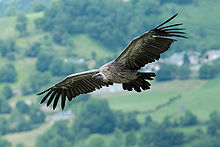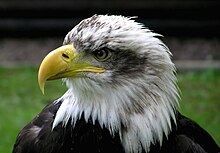From Wikipedia, the free encyclopedia
In most cases, the females are larger than the males.
Contents
Definition
Many species of bird may be considered partly or exclusively predatory; however, in Ornithology, the term "bird of prey" applies only to birds of the families listed below. Taken literally, the term "bird of prey" has a wide meaning that includes many birds that hunt and feed on animals and also birds that eat very small insects.[2] In ornithology, the definition for "bird of prey" has a narrower meaning; birds that have very good eyesight for finding food, strong feet for holding food, and a strong curved beak for tearing flesh.[3]Most birds of prey also have strong curved talons for catching or killing prey.[3][4]By way of an example, the narrower definition excludes storks and gulls, which can eat quite large fish, partly because these birds catch and kill prey entirely with their beaks,[2] and similarly bird-eating skuas, fish-eating penguins, and vertebrate-eating kookaburras are excluded. Birds of prey generally prey on vertebrates, which are usually quite large relative to the size of the bird.[2] Most also eat carrion, at least occasionally, and vultures and condors eat carrion as their main food source.[3]Classification by ancestry
The diurnal birds of prey are formally classified into five families (traditionally of the order Falconiformes, a classification currently[vague] in flux):- Accipitridae: hawks, eagles, buzzards, harriers, kites and Old World vultures
- Pandionidae: the osprey (sometimes classified as subfamily Pandioninae of the previous family)
- Sagittariidae: the secretary bird
- Falconidae: falcons and caracaras
The observation that otherwise unrelated bird groups may perform similar ecological roles and bear striking morphological similarities to one another is explained by the concept of convergent evolution.
Common names
The common names for various birds of prey are based on structure, but many of the traditional names do not reflect the evolutionary relationships between the groups.- Eagles tend to be large birds with long, broad wings and massive feet. Booted eagles have legs and feet feathered to the toes and build very large stick nests.
- Ospreys, a single species found worldwide that specializes in catching fish and builds large stick nests.
- Kites have long wings and relatively weak legs. They spend much of their time soaring. They will take live vertebrate prey, but mostly feed on insects or even carrion.
- The true hawks are medium-sized birds of prey that usually belong to the genus Accipiter (see below). They are mainly woodland birds that hunt by sudden dashes from a concealed perch. They usually have long tails for tight steering.
- Buzzards are medium-large raptors with robust bodies and broad wings, or, alternatively, any bird of the genus Buteo (also commonly known as "hawks" in North America).
- Harriers are large, slender hawk-like birds with long tails and long thin legs. Most use a combination of keen eyesight and hearing to hunt small vertebrates, gliding on their long broad wings and circling low over grasslands and marshes.
- Vultures are carrion-eating raptors of two distinct biological families: the (Accipitridae), which only occurs in the Eastern Hemisphere; and the (Cathartidae), which only occurs in the Western Hemisphere. Members of both groups have heads either partly or fully devoid of feathers.
- Falcons are medium-size birds of prey with long pointed wings. Unlike most other raptors, they belong to the Falconidae, rather than the Accipitridae. Many are particularly swift flyers. Caracaras are a distinct subgroup of the Falconidae unique to the New World, and most common in the Neotropics – their broad wings, naked faces and appetites of a generalist suggest some level of convergence with either the Buteos or the vulturine birds, or both.
- Owls are variable-sized, typically night-specialized hunting birds. They fly almost silently due to their special feather structure that reduces turbulence. They have particularly acute hearing.




No comments:
Post a Comment